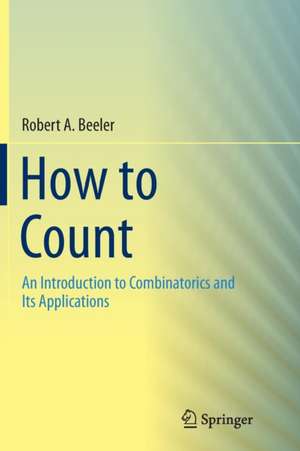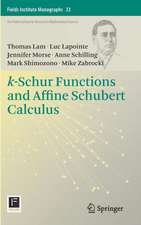How to Count: An Introduction to Combinatorics and Its Applications
Autor Robert A. Beeleren Limba Engleză Paperback – 29 oct 2016
| Toate formatele și edițiile | Preț | Express |
|---|---|---|
| Paperback (1) | 459.38 lei 6-8 săpt. | |
| Springer International Publishing – 29 oct 2016 | 459.38 lei 6-8 săpt. | |
| Hardback (1) | 466.87 lei 6-8 săpt. | |
| Springer International Publishing – 27 mar 2015 | 466.87 lei 6-8 săpt. |
Preț: 459.38 lei
Nou
Puncte Express: 689
Preț estimativ în valută:
87.91€ • 95.46$ • 73.85£
87.91€ • 95.46$ • 73.85£
Carte tipărită la comandă
Livrare economică 22 aprilie-06 mai
Preluare comenzi: 021 569.72.76
Specificații
ISBN-13: 9783319355085
ISBN-10: 3319355082
Pagini: 376
Ilustrații: XV, 361 p. 61 illus., 2 illus. in color.
Dimensiuni: 155 x 235 x 20 mm
Greutate: 0.53 kg
Ediția:Softcover reprint of the original 1st ed. 2015
Editura: Springer International Publishing
Colecția Springer
Locul publicării:Cham, Switzerland
ISBN-10: 3319355082
Pagini: 376
Ilustrații: XV, 361 p. 61 illus., 2 illus. in color.
Dimensiuni: 155 x 235 x 20 mm
Greutate: 0.53 kg
Ediția:Softcover reprint of the original 1st ed. 2015
Editura: Springer International Publishing
Colecția Springer
Locul publicării:Cham, Switzerland
Cuprins
Preliminaries.- Basic Counting.- The Binomial Coefficient.- Distribution Problems.- Generating Functions.- Recurrence Relations.- Advanced Counting - Inclusion and Exclusion.- Advanced Counting - Polya Theory.- Application: Probability.- Application: Combinatorial Designs.- Application: Graph Theory.- Appendices.
Recenzii
“The book is an excellent introduction tocombinatorics. … The author uses a clear language and often provides an easyintuitive access to abstract subjects. The presentation is well motivated, theexplanations are transparent and illustrated by carefully selected examples.Each section ends with a list of well formulated exercises which make the bookideally suited for self-instruction.” (Astrid Reifegerste, zbMATH 1328.05001,2016)
“This book by Beeler … is an excellent introductorytext on combinatorics. The author gives the right balance of theory,computation, and applications, and he presents introductory-level topics, suchas the multiplication principle, binomial theorem, and distribution problems ina clear manner. … Summing Up: Highly recommended. Upper-division undergraduatesthrough researchers and faculty.” (S. L. Sullivan, Choice, Vol. 53 (1),September, 2015)
“This book by Beeler … is an excellent introductorytext on combinatorics. The author gives the right balance of theory,computation, and applications, and he presents introductory-level topics, suchas the multiplication principle, binomial theorem, and distribution problems ina clear manner. … Summing Up: Highly recommended. Upper-division undergraduatesthrough researchers and faculty.” (S. L. Sullivan, Choice, Vol. 53 (1),September, 2015)
Notă biografică
Robert A. Beeler is an Associate Professor of Mathematics at East Tennessee State University. His research interests include enumerative combinatorics and graph theory; edge decompositions of graphs, graceful labelings on graphs, intersection/representation theory, and combinatorial designs; combinatorial games and games on graphs. He is a member of the Mathematics Association of America, the American Mathematical Society, and the Institute of Combinatorics and its Applications.
Textul de pe ultima copertă
Providing a self-contained resource for upper undergraduate courses in combinatorics, this text emphasizes computation, problem solving, and proof technique. In particular, the book places special emphasis the Principle of Inclusion and Exclusion and the Multiplication Principle. To this end, exercise sets are included at the end of every section, ranging from simple computations (evaluate a formula for a given set of values) to more advanced proofs. The exercises are designed to test students' understanding of new material, while reinforcing a working mastery of the key concepts previously developed in the book. Intuitive descriptions for many abstract techniques are included. Students often struggle with certain topics, such as generating functions, and this intuitive approach to the problem is helpful in their understanding. When possible, the book introduces concepts using combinatorial methods (as opposed to induction or algebra) to prove identities. Students are also asked toprove identities using combinatorial methods as part of their exercises. These methods have several advantages over induction or algebra.
Caracteristici
A problem-based approach to learning Combinatorics Very computational in its orientation, with an added emphasis on Proof technique Written from the perspective of the student, with an abundance of exercises at the end of each section All computer simulations prepared in open-source SAGE software Includes supplementary material: sn.pub/extras














